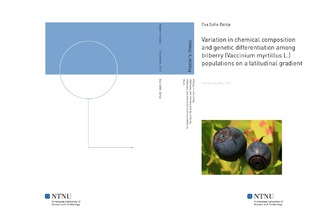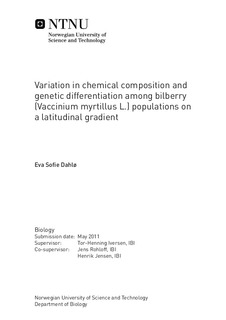| dc.description.abstract | Bilberry (Vaccinium myrtillus) is native to Europe and North America and constitutes an important nutritional resource for both humans and animals. Over the years, a series of chemical analyses have revealed several health-beneficial compounds in bilberry, and with the current demand of the berries mainly covered by Sweden and Eastern Europe, there has become an increasing desire to cultivate bilberry in Norway. In order for such cultivation to be successful an increased knowledge about bilberry is seen as essential and thus several studies have investigated the chemical composition of the berry. However, the underlying genetic diversity and the variation between populations in biochemical compounds remain to be thoroughly investigated. Therefore, the aim of present study was to investigate the differences in biochemical composition between populations of bilberry distributed on a latitudinal gradient, and estimate the level of genetic variation within and among the populations. This in order to examine whether biochemical composition was reflected by observed levels of genetic variation.Bilberries from four Norwegian populations at three regions differing in latitude were analysed for content of total phenolics (TPH), total anthocyanins (ACY) and antioxidant activity (FRAP). Furthermore, metabolic profiling was performed by gas chromatography-mass spectrometry (GC-MS) to reveal biochemical differences between the populations in content of sugars, acids and some simple phenolics. Multivariate statistics were performed and revealed a clustering of samples from the two locations in Mid-Norway, and a clustering of the northern with the southern population. In addition, there were found significant differences in some of the compounds between the populations.Genetic analyses using four microsatellites were carried out to examine whether metabolic differences between populations were reflected by genetic differentiation. Despite the significant differences between populations in the concentrations of some metabolites no significant genetic differentiation was found. Thus, it seems that the variation in biochemical compounds discovered among populations could be environmentally induced differences on a similar genetic background. However, due to the limited number of working microsatellites and the fact that these molecular markers are neutral, there is still a possibility that the genetic differences causing compound concentrations to differ could be so minor as to remain undetected. Hence, further studies utilizing more microsatellite markers or new state-of-the-art molecular techniques are needed to determine whether this result holds and is valid also for genetic variation in coding parts of the genome. | nb_NO |

